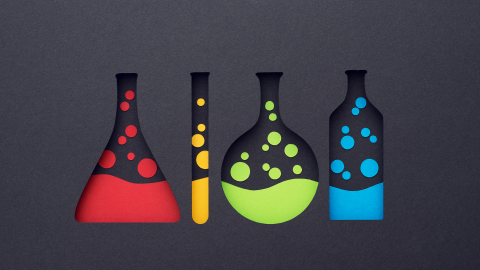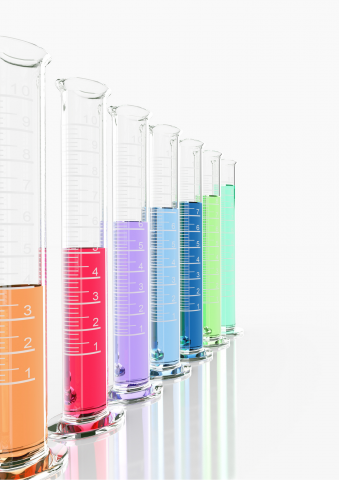
PhD PROGRAM CHEMISTRY - GRADUATE SCHOOL CHEMISTRY
This doctoral program is dedicated to chemists, who want to start a PhD at Université Paris Saclay. Because chemistry is one the main pillars in sciences, we offer immersive doctoral programs for motivated students to reach the highest level in chemical sciences.
Our open-minded doctoral school carries out inorganic, organic, analytical, physical, material and biological chemistries in the best laboratories at the south of Paris.
Chemical Sciences / Organic Chemistry / Inorganic Chemistry / Analysis and Instrumentation / Biosystems and Biochemistry
Program content
For this program, you will be attached to the doctoral school Chemical sciences: molecules, materials, instrumentation and bio systems (2MIB)
The doctoral school "Chemical Sciences: Molecules, Materials, Instrumentation and Biosystems (2MIB)" is a disciplinary school based on the components of chemistry of the Paris-Saclay perimeter which cover a large part of the spectrum of the discipline. Its ambition is to offer doctoral students a training space for fundamental research and its applications in response to societal challenges, typically in the field of environment, sustainable development, materials, biology or pharmacology.
The ED is organized around 3 poles or intra-ED programs
- Physical, BioPhysical and Analytical Chemistry (CPBA)
- Organic and Biomolecular Chemistry (BOC)
- Inorganic Chemistry and Materials (CIM)
Two transverse axes are added to these three poles :
- The professional integration and international mobility of doctoral students
- Doctoral training
Learn more about the doctoral school
|
|
|
|
|
|
|
|
|
|
|
|
|
|
|
|
|
|
|
|
|
|
|
|
|
|
|
|
|
|
|
|
|
|
|
|
|
|
|
|
|
|
|
|
|
|
|
|
|
|
|
|
|
|
|
|
|
|
|
|
|
|
|
|
|
|
|
|
|
|
|
|
|
|
|
|
|
|
|
|
Doctoral students admitted to the doctoral program will have a public law doctoral contract. The duration of the contract is 3 years. The contractual doctoral students are full-time employees with the sole or main mission of carrying out their doctoral project. They may also be entrusted with complementary missions of teaching, scientific mediation, valorization or expertise.
Possible employers* for doctoral students under contract to the program are :
- Université Paris-Saclay (Faculties of Sciences of Orsay, Medicine, Pharmacy, Sports Sciences and Law-Economy-Economy-Management)
- University of Versailles Saint Quentin en Yvelines
- University of Evry Val d'Essonne
- Centrale Supélec
- ENS Paris-Saclay
- Agro Paris Tech
* This list remains to be completed or specified
The PhD within the doctoral school imposes an annual monitoring committee with two researchers or teacher-researchers from outside the project and the laboratory in which the thesis is done. In addition, the doctoral school, through its director, its assistant directors and its secretariat is attentive to the smooth running of the doctoral program and the well-being of its doctoral students. From the day of their arrival, the first years are invited to contact their cluster director and/or the monitoring committee in case of difficulty. If the thesis is stopped, the doctoral school systematically schedules an interview to find out the reasons why.
The employment rate of doctors from the 2MIB doctoral school is excellent at 94% with a salary level of 37,000 euros per year for the years 2016-2018. The parity is almost perfect for our graduates (52% women and 48% men). Finally, we note that the vast majority of the doctoral school's doctors are 87% satisfied with their jobs.
Find all the statistics on the jobs of our doctors here
How to be admitted to the doctoral program in chemistry?
Find below the different steps to apply for the Chemistry Program - Graduate School Chemistry
Prerequisite
The recruitment of a doctoral student is subject to obtaining a master's degree (engineer or equivalent with the possibility of VAE) or equivalent in chemistry from a French or foreign university.
Jury Evaluation Criteria
1. Background and skills
- Academic background, diplomas obtained, student's ranking
- Past research experiences, internship and quality of the associated internship report
- Letter of recommendation from supervisors
2. Stakes and originality of the subject, understanding of the scientific context
- Proposed scientific approach
- Quality of the presentation and answers to questions
The jury
The director of each cluster constitutes the cluster's recruitment jury. The Graduate School of Chemistry as well as all the HDRs of the ED are informed of the composition of the jury.
The steps
Here are the 2 main steps to be part of the Chemistry - Graduate School Chemistry Program
- To apply the student must apply on ADUM by choosing a proposed subject (or several subjects).
- If the student is eligible (after analysis of his or her file) there is then a 30 min audition with 10-15 minutes of presentation + questions and discussion with the jury.

Calendar 2024 - Candidates
- january 26, 2024
Deadline for submission of thesis topics on ADUM - April 4, 2023
Closing date for applications on ADUM - Tuesday May 21 to Thursday May 23, 2024
Candidate hearings by cluster juries - April 26, 2024
Publication of competition eligibility results
Communication tools
THE EMPLOYMENT STATUS OF GRADUATE SCHOOL CHEMISTRY PHDS AS OF DECEMBER 1, 2019

